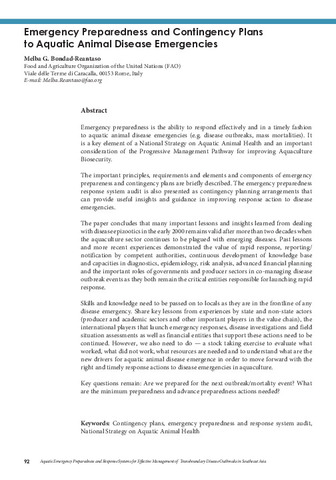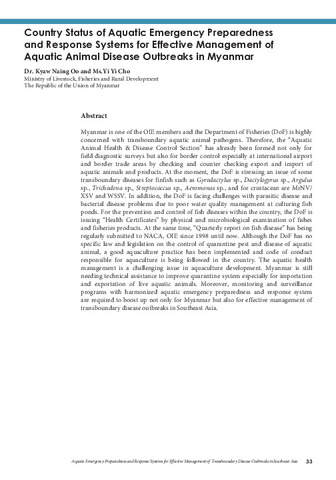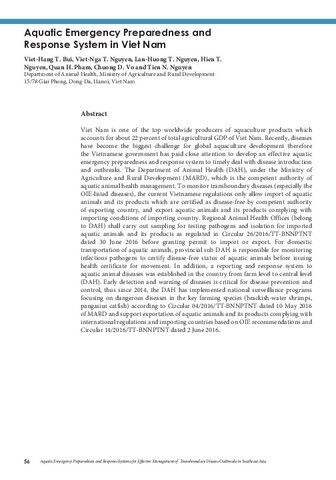Emergency preparedness and contingency plans to aquatic animal disease emergencies
- Global styles
- MLA
- Vancouver
- Elsevier - Harvard
- APA
- Help
Share
Abstract
Emergency preparedness is the ability to respond effectively and in a timely fashion to aquatic animal disease emergencies (e.g. disease outbreaks, mass mortalities). It is a key element of a National Strategy on Aquatic Animal Health and an important consideration of the Progressive Management Pathway for improving Aquaculture Biosecurity.The important principles, requirements and elements and components of emergency prepareness and contingency plans are briefly described. The emergency preparedness response system audit is also presented as contingency planning arrangements that can provide useful insights and guidance in improving response action to disease emergencies.The paper concludes that many important lessons and insights learned from dealing with disease epizootics in the early 2000 remains valid after more than two decades when the aquaculture sector continues to be plagued with emerging diseases. Past lessons and more recent experiences demonstrated the value of rapid response, reporting/notification by competent authorities, continuous development of knowledge base and capacities in diagnostics, epidemiology, risk analysis, advanced financial planning and the important roles of governments and producer sectors in co-managing disease outbreak events as they both remain the critical entities responsible for launching rapid response.Skills and knowledge need to be passed on to locals as they are in the frontline of any disease emergency. Share key lessons from experiences by state and non-state actors (producer and academic sectors and other important players in the value chain), the international players that launch emergency responses, disease investigations and field situation assessments as well as financial entities that support these actions need to be continued. However, we also need to do - a stock taking exercise to evaluate what worked, what did not work, what resources are needed and to understand what are the new drivers for aquatic animal disease emergence in order to move forward with the right and timely response actions to disease emergencies in aquaculture.Key questions remain: Are we prepared for the next outbreak/mortality event? What are the minimum preparedness and advance preparedness actions needed?
Suggested Citation
Bondad-Reantaso, M. G. (2019). Emergency preparedness and contingency plans to aquatic animal disease emergencies. In E. A. Tendencia, L. D. de la Peña, & J. M. V. de la Cruz (Eds.), Aquatic Emergency Preparedness and Response Systems for Effective Management of Transboundary Disease Outbreaks in Southeast Asia: Proceedings of Asean Regional Technical Consultation, 20-22 August 2018, Centara Grand Central Ladprao, Bangkok, Thailand (pp. 92-98). Tigbauan, Iloilo, Philippines: Aquaculture Department, Southeast Asian Fisheries Development Center.
Type
Conference paperISBN
9789719931089
Related items
Showing items related by title, author, creator and subject.
-
Country status of aquatic emergency preparedness and response systems for effective management of aquatic animal disease outbreaks in Myanmar
Oo, Kyaw Naing; Cho, Yi Yi (Aquaculture Department, Southeast Asian Fisheries Development Center, 2019)Myanmar is one of the OIE members and the Department of Fisheries (DoF) is highly concerned with transboundary aquatic animal pathogens. Therefore, the Aquatic Animal Health & Disease Control Section has already been ... -
FAO TCP/INT/3501: Emergency preparedness and response systems capacity and performance self-assessment survey
Tendencia, Eleonor A.; de la Peña, Leobert D.; de la Cruz, Joesyl Marie V.; FAO (Aquaculture Department, Southeast Asian Fisheries Development Center, 2019)The purpose of this survey is to obtain information on national capacity and the agencies mandated to implement emergency preparedness and response systems with respect to aquatic animal diseases. The results of this survey ... -
Aquatic emergency preparedness and response system in Viet Nam
Bui, Viet-Hang T.; Nguyen, Viet-Nga T.; Nguyen, Lan-Huong T.; Nguyen, Hien T.; Pham, Quan H.; Vo, Chuong D.; Nguyen, Tien N. (Aquaculture Department, Southeast Asian Fisheries Development Center, 2019)Viet Nam is one of the top worldwide producers of aquaculture products which accounts for about 22 percent of total agricultural GDP of Viet Nam. Recently, diseases have become the biggest challenge for global aquaculture ...






